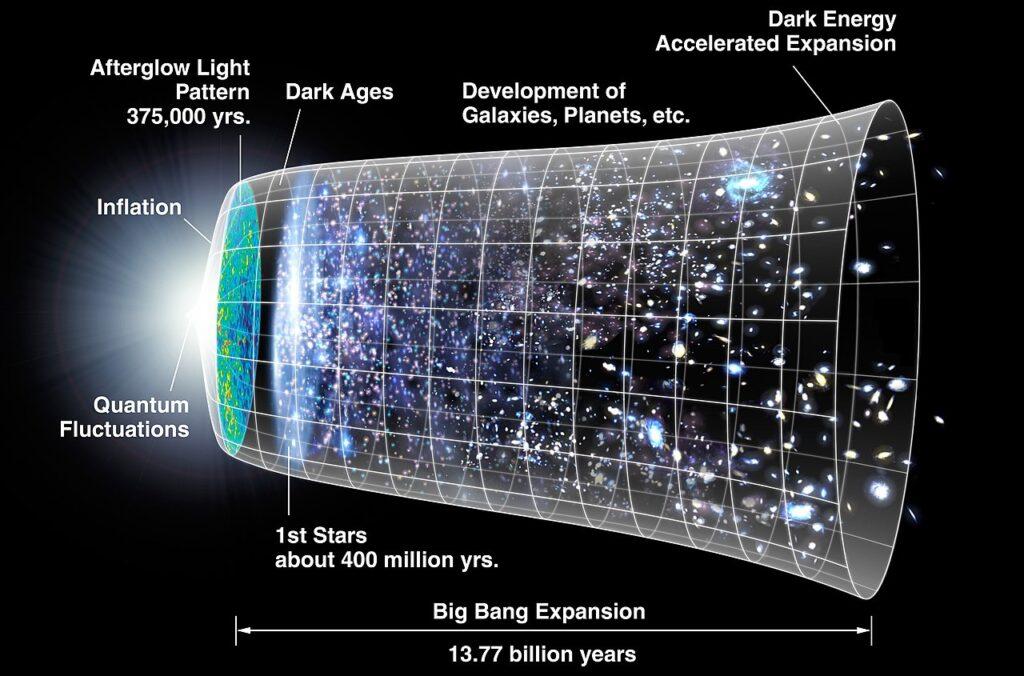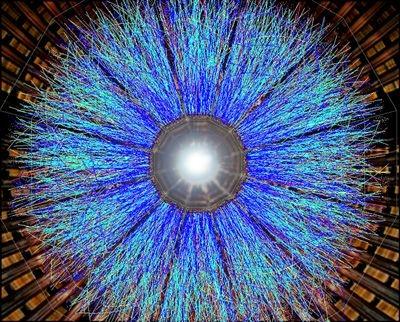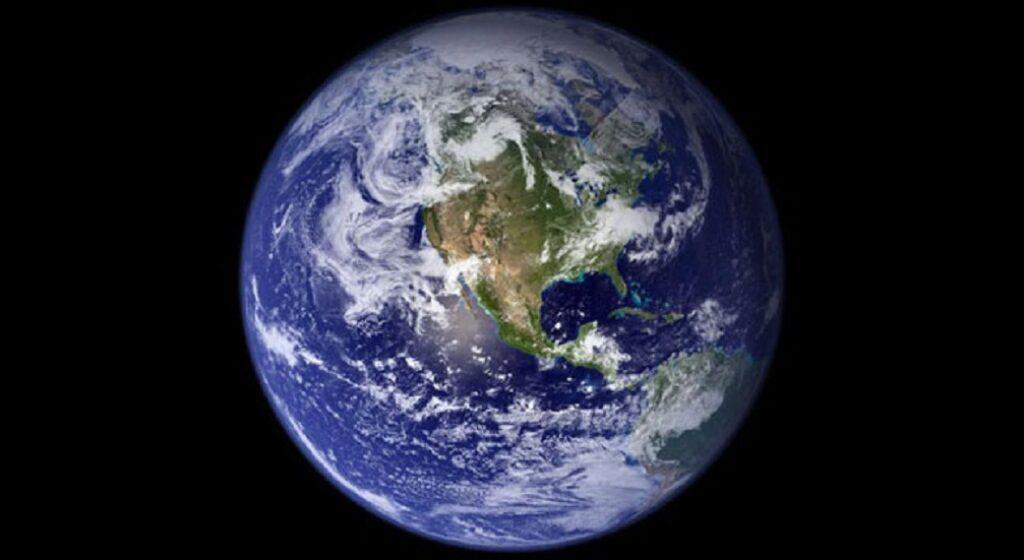Where did everything come from? What is our history?
In this post, you can get the complete history of our existence. Here, you can find the complete story of the Universe starting from the Big Bang, the formation of stars, and planets, life evolving on Earth, and many more. So, let’s get started.

Image Credit: NASA
A Timeline of the metric expansion of space, where space, including hypothetical non-observable portions of the universe, is represented at each time by the circular sections. On the left, the dramatic expansion occurs in the inflationary epoch.
The Big Bang
About 13.8 billion years ago, our universe was born with the Big Bang. The Big Bang wasn’t really an explosion, as the theory’s name might suggest. Instead, it was the appearance of space everywhere in the universe. It was a period when the universe was extremely hot and dense and space began to expand outward in all directions at once. Big Bang is actually a moment in time, not a point in space. The Big Bang is really a moment at which our current understanding of the universe breaks down.
Actually, we still don’t know the exact conditions under which this Big Bang happened, and whether there was a time before time. Astronomers, cosmologists, and particle physicists are continuously working on it, and hopefully, we will definitely get something in the near future.

Image Credit: Astronomy Magazine
Cosmic inflation era
After the Big Bang, the next trick of the universe was to grow really fast. When the universe was very young — something like a hundredth of a billionth of a trillionth of a trillionth of a second — it underwent an incredible growth spurt.
This era is known as inflation. It remains hypothetical, but cosmologists like this idea because it explains why far-flung regions of space appear so similar to one another, despite being separated by vast distances.
Between about trillionth and millionth of a second after the Big Bang, neutrinos, quarks, and electrons were formed.

Image Credit: mit.edu
Quark-gluon plasma
About a millionth of a second after the big bang, the universe was really hot. It was something like between 4 trillion and 6 trillion degrees Celsius hot. At such temperatures, matter existed in the form of quark-gluon plasma.
The elementary particles called quarks, which are normally bound tightly inside of protons and neutrons, wandered around freely. And Gluons, which carry a fundamental force known as the strong force, are mixed in with these quarks in a soupy primordial fluid.
The early epoch
There were a lot of incidents that happened in the next stage of time, which began around a few thousandths of a second after the Big Bang. As the cosmos expanded, it cooled, and soon conditions were fair enough for quarks to come together into protons and neutrons. One second after the Big Bang, the density of the universe dropped enough so that neutrinos could fly forward without hitting anything and it was creating the cosmic neutrino background, which scientists have yet to detect.

Image Credit: livescience.com
The first atoms
Within about 3 minutes after the Big Bang, conditions cooled enough for these protons and neutrons to form lighter nuclei. This is called the era of nucleosynthesis. Protons and neutrons were fusing together and formed deuterium and helium as well as a tiny amount of lithium. But after about 20 minutes the temperature fell and no further nuclei could form.
The problem at this point was that electrons couldn’t stay in orbit around an atomic nucleus because of the immense heat and radiation still flooding the universe.
Finally, after 380,000 years or so, the universe had again expanded and cooled enough for conditions to favor electrons staying in orbit around atomic nuclei. Actually, things became cool enough so that atomic nuclei could combine with free electrons and the universe got its first atom which was hydrogen.
It was the time when the cosmic microwave background was generated, because the atoms that formed entered their lowest energy state quickly after, releasing excess energy in the form of photons that could finally travel freely through the universe without knocking into anything along the way. This is the light that makes up the cosmic microwave background.

Image Credit: Astronomy Magazine
The dark ages
For a very long time, nothing in the universe gave off light. This period, which lasted around 100 million years, is known as the Cosmic Dark Ages. This epoch remains extremely difficult to study because astronomers’ knowledge of the universe comes almost entirely from starlight. Without any stars, it’s difficult to know what went on.
The first stars
By around 180 million years after the Big Bang, hydrogen started converting into Helium and the formation of stars began all over the universe. And due to the formation of innumerable stars, the universe began to glow with light.
Large-Scale structure
After a few million years the small early galaxies began to merge together into larger galaxies and, around 1 billion years after the Big Bang, supermassive black holes formed in their centers. Bright quasars, which produce intense beacons of light that can be seen from 12 billion light-years away, were turned on.
The universe’s middle years
The universe continued to evolve over the next several billion years. Spots of higher density from the primordial universe gravitationally attracted matter to themselves. They slowly grew into galactic clusters and long strands of gas and dust, producing a beautiful filamentary cosmic web that can be seen today.

Image Credit: Worldatlas
Birth of the solar system
After the Big Bang, the process of creation and destruction continued continuously in the universe for almost 8 billion years. And due to one such event, about 4.5 billion years ago, in one particular galaxy, a cloud of gas collapsed down into a yellow star with a system of rings around it. Those rings coalesced into eight planets, plus various comets, asteroids, dwarf planets, and moons, forming a familiar stellar system. That stellar system is known as a Solar system, the star in the center of the system is known as Sun, and the planet third from the Sun is our Earth.

Image Credit: NASA
Earth and humanity
It took millions of years for our Sun to form and after that, the planets started forming around it. And our earth is one of those planets which was formed at that time.
Up to hundreds of years, after its creation, our earth rotated so fast that it used to have a day of only 7 hours. Slowly the earth started getting cold and due to the steam, it started raining on it. And the creation of the creature world began.
In the early stages, unicellular life began. Seas and oceans were formed all around. Earth became full of water and cells were formed about one and a half billion years ago.
- About 510 million years ago life mainly started in the oceans.
- And about 420 million years ago life on land flourished in the form of vegetation. And 15 million years later, there were forests all around the earth.
- And 380 million years ago, a day on Earth became up to 22 hours. Around 350 million years ago some sea creatures stepped onto the earth and 300 million years ago, there was an abundance of reptiles on the earth.
- Around 230 million years ago the era of dinosaurs began.
- By 200 million years ago, flying organisms started.
- 65 million years ago, a large number of meteorites rained on the earth. And the dinosaurs died out. At that time not only dinosaurs but every living being on the earth heavier than 25 kilograms died. And only very small creatures and sea creatures of the earth were successful in saving their existence.
- Mammalian organisms started on our earth 63 million years ago. And again life began to flourish on earth.
- Modern mammals were born around 45 million years ago.
- And about 6 million years ago, those chimpanzees appeared on the earth who were to become humans. This gradual development lasted for 4.5 million years.
- And about 1.5 million years ago, the origin of the primitive man took place.
- 1.4 million years ago primitive man learned to control fire. And this period of learning from nature continued for millions of years.
- 75 thousand years ago, even primitive humans started living in caves. Gradually, the brains of cave humans developed and they started becoming modern humans. They started using animal skins as clothes, started burning fire, started eating cooked food, and even discovered the wheel.
- 15 thousand years ago there was a big development in agriculture. And humans started growing paddy themselves, started making shelters for themselves, and after that the civilizations started. When many empires were established in India and Europe, the largest pyramids started being built in Giza of Egypt. And the world started moving towards modernization.
- Modern science started in the year 1543. With the scientific revolution, we went ahead with various discoveries.
- The first industrial revolution took place in the year 1760.
- In 1957 the space age began and the human eye reached the sky.
- In 1969, this little creature on Earth, man, broke the mystery of gravity and stepped on the moon.
- And today we are living in the modern era with many discoveries.
Many congratulations to you and us for this success of humanity present in some corner of the infinite universe.

Chandan Gupta
Chandan Kumar Gupta is a Nuclear Physicist, former assistant professor, author, and founder of EduVigyan.com. He holds an M.Sc. in Physics from the University of Delhi and a B.Sc. in Physics from St. Xavier’s College, Ranchi. He is a researcher and he is the author or co-author of several research articles on Nuclear Physics. To see his latest articles, you can follow him on ResearchGate.

Bah.. kya batt h.. 🍀